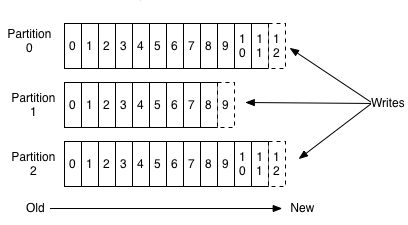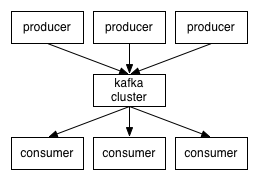Chapter 3. Apache Kafka Concepts
This chapter describes several basic concepts that support fault-tolerant, scalable messaging provided by Apache Kafka:
Topics
Producers
Consumers
Brokers
For additional introductory information about Kafka, see the Apache introduction to Kafka. For an example that simulates the use of streaming geo-location information (based on a previous version of Kafka), see Simulating and Transporting the Real-Time Event Stream with Apache Kafka.
Topics
Kafka maintains feeds of messages in categories called topics. Each topic has a user-defined category (or feed name), to which messages are published.
For each topic, the Kafka cluster maintains a structured commit log with one or more partitions:

Kafka appends new messages to a partition in an ordered, immutable sequence. Each message in a topic is assigned a sequential number that uniquely identifies the message within a partition. This number is called an offset, and is represented in the diagram by numbers within each cell (such as 0 through 12 in partition 0).
Partition support for topics provides parallelism. In addition, because writes to a partition are sequential, the number of hard disk seeks is minimized. This reduces latency and increases performance.
Producers
Producers are processes that publish messages to one or more Kafka topics. The producer is responsible for choosing which message to assign to which partition within a topic. Assignment can be done in a round-robin fashion to balance load, or it can be based on a semantic partition function.
Consumers
Consumers are processes that subscribe to one or more topics and process the feeds of published messages from those topics. Kafka consumers keep track of which messages have already been consumed by storing the current offset. Because Kafka retains all messages on disk for a configurable amount of time, consumers can use the offset to rewind or skip to any point in a partition.
Brokers
A Kafka cluster consists of one or more servers, each of which is called a broker. Producers send messages to the Kafka cluster, which in turn serves them to consumers. Each broker manages the persistence and replication of message data.

Kafka Brokers scale and perform well in part because Brokers are not responsible for keeping track of which messages have been consumed. Instead, the message consumer is responsible for this. This design feature eliminates the potential for back-pressure when consumers process messages at different rates.

